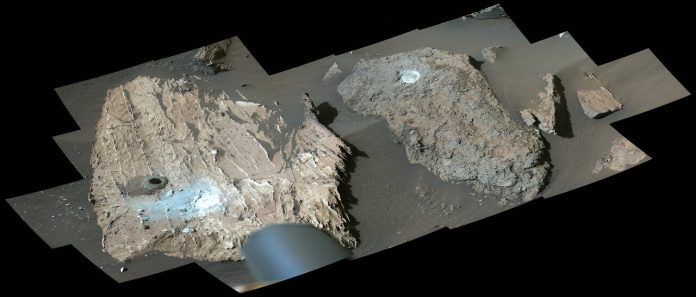
NASA’s Perseverance rover has made an exciting discovery on Mars that could help answer one of humanity’s biggest questions: Was there ever life on the Red Planet?
The rover found a rock, nicknamed “Cheyava Falls,” with some fascinating features that suggest it might hold signs of ancient life.
Cheyava Falls is an arrowhead-shaped rock with veins running through it, and it has captured the attention of the science team.
The rock was collected on July 21 as the rover explored the northern edge of Neretva Vallis, an ancient river valley in Jezero Crater.
This area was carved by water rushing into the crater long ago, making it a prime spot to search for signs of past life.
The Perseverance rover is equipped with several instruments that can analyze rocks and soil on Mars.
One of these instruments, called SHERLOC, detected organic compounds in Cheyava Falls.
Organic compounds are carbon-based molecules that are considered the building blocks of life. However, these compounds can also be formed by non-biological processes, so more research is needed to determine if they are truly signs of ancient life.
Ken Farley, a scientist on the Perseverance team from Caltech, described Cheyava Falls as “the most puzzling, complex, and potentially important rock yet investigated by Perseverance.”
The rock contains colorful spots that indicate chemical reactions that could have been used as an energy source by microbial life. It also shows clear evidence that water, which is necessary for life, once flowed through it.
The team found that the rock’s white veins are made of calcium sulfate, while the red bands suggest the presence of hematite, a mineral that gives Mars its rusty color.
Within these red regions, the rover found off-white splotches surrounded by black halos, resembling leopard spots. The PIXL instrument determined that these black halos contain iron and phosphate, elements that are often associated with microbial life on Earth.
David Flannery, an astrobiologist from the Queensland University of Technology in Australia, noted that similar features on Earth are often linked to fossilized microbes.
These spots can form when chemical reactions involving hematite turn the rock from red to white, releasing iron and phosphate in the process. Such reactions can provide energy for microbes, which might explain the association between these features and life on Earth.
One possible scenario is that Cheyava Falls was originally deposited as mud with organic compounds mixed in.
Over time, this mud cemented into rock, and a second episode of fluid flow created the white calcium sulfate veins and the leopard spots.
However, the team also discovered millimeter-sized crystals of olivine in the veins. Olivine is a mineral that forms from magma, raising the possibility that the rock was exposed to high temperatures, creating an abiotic reaction.
To get a clearer picture of what really happened in this Martian river valley billions of years ago, scientists want to bring the Cheyava Falls sample back to Earth. Here, they can study it with powerful laboratory instruments that are not available on the rover.
Nicola Fox, an associate administrator at NASA, emphasized the importance of this discovery. “We have designed the route for Perseverance to ensure that it goes to areas with the potential for interesting scientific samples,” she said.
“This trip through the Neretva Vallis riverbed paid off as we found something we’ve never seen before, which will give our scientists so much to study.”
Morgan Cable, a scientist on the Perseverance team, is excited about the potential of this discovery. With further study, Cheyava Falls could provide the evidence needed to confirm that life once existed on Mars. This finding brings us one step closer to answering the age-old question of whether we are alone in the universe.



